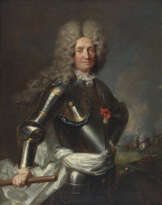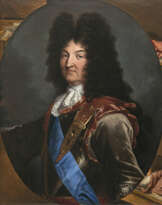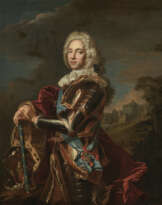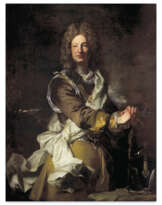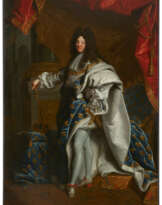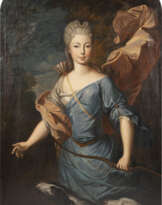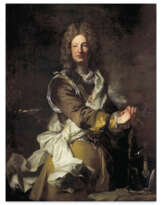ID 842525
Lot 694 | Hyacinthe Rigaud
Estimate value
€ 20 000 – 40 000
1659 Perpignan - 1743 Paris
and associate
Title: Self Portrait with Palette.
Date: ca. 1705-1706.
Technique: Oil on canvas.
Mounting: Relined.
Measurement: 96 x 63cm.
Frame: Framed.
Verso:
Inscribed on the doubling canvas.
Provenance:
Private ownership, Germany.
When one thinks of Louis XIV's France, of fabrics and velvet in dazzling colours, of calm and deliberate elegance, one also thinks of paintings and, above all, of portraits by Hyacinthe Rigaud. Rigaud has immortalised the faces of the historical figures we all learned about at school and whose deeds have been praised by historians, extolled by novelists and sung about by poets. Hyacinthe Rigaud sums up and glorifies an unrepeatable era in his work.
The artist was born in 1659 in Perpignan, far from the French capital, and became the undisputed star of French painting in the first half of the 18th century. He became best known for his depiction of the Sun King in the famous portrait of Louis XIV in his coronation robes, which earned him the appointment of court painter in 1701. From then on, he began to paint portraits of most of the prominent figures of the Ancien Régime. With his work, Rigaud celebrated not only the splendour of the Versailles court but also his loyalty to the French Bourbon dynasty, whose portraits he painted over four generations. He also worked for figures of the nobility, clergy, bourgeoisie, financiers, industrialists and ministers, helping to create an almost complete portrait gallery of the leading figures of the Kingdom of France between 1680 and 1740. A small part of his painting output consists of more discreet personalities such as friends, relatives, other artists or simply merchants.
Even during his training, the young Rigaud chose the works of the Flemish painter Anton van Dyck as his sole artistic guide, whose paintings he copied and whose works he collected. Biographers and art writers are unanimous in emphasising that Rigaud's painting is indebted to that of his famous Flemish predecessor, so that the French painter is referred to as the French Van Dyck. Antoine Joseph Dezallier d'Argenville, who wrote the most comprehensive summary of the life of the most famous painters (1745), wrote after Rigaud's death that "France has lost its Van Dyck in Hyacinthe Rigaud".
In view of the enormous volume of work that Rigaud had to complete in just a few years, the French painter was forced to hire collaborators from 1694 onwards to help him realise his works. Joseph Christophe, Jacques Mélingue, the engraver Claude Leroy, Nattier, Barthélemy and Hérault were among his closest collaborators in this respect and worked with him in his workshop, learning his techniques and studying his most important works. From 1695 onwards, as the number of commissions increased, Rigaud had to further increase the number of his assistants. At this point the question of Rigaud's authentic autography in his works arises. Given the precision he maintained in the details of the faces, the hands and the animation of the draperies, one can conclude, as with other important painters and portraitists of his time before and after him, that Rigaud reserved the most complex parts and the most distinctive features of his works for himself, leaving the outlines or less significant elements to his assistants.
Like other artists, Rigaud made several portraits of himself: These portraits were either intended for friends or commissioned for collections of artists' portraits. The present work bears the date 1705 on the reverse, referring to the self-portrait commissioned from the painter by the Grand Duke of Tuscany Cosimo III in 1705, but which sank in the sea in 1706. According to Ariane James-Sarazin, the treatment of the face, the open shirt collar, the hand holding the palette and the gold-rimmed robe seem to be of high quality and to fit Rigaud. The wig, on the other hand, seems to the art historian to be of inferior quality, as does the depiction of the blue bow in the hair. For this reason, James-Sarazin considers this to be the work of Rigaud himself and his workshop, perhaps the work of Adrien Leprieur, or perhaps the little-known Monmorency, which is limited to the area of the hair. However, the question cannot be conclusively settled: Although Rigaud and his workshop produced some replicas of the self-portrait sunk in the sea in 1705-1706, the present work has been restored in the very part that James-Sarazin assumes to be that of the workshop. For this reason, it is unclear whether it is a modern intervention - a restorer - or an ancient intervention, i.e. Rigaud's workshop.
We are grateful to Ariane James-Sarazin, Paris, for her help in cataloguing the present painting.
| Artist: | Hyacinthe Rigaud (1659 - 1743) |
|---|---|
| Applied technique: | Oil |
| Auction house category: | Old Masters |
| Artist: | Hyacinthe Rigaud (1659 - 1743) |
|---|---|
| Applied technique: | Oil |
| Auction house category: | Old Masters |
| Address of auction |
VAN HAM Kunstauktionen GmbH Hitzelerstr. 2 50968 Köln Germany | ||||||||||||||
|---|---|---|---|---|---|---|---|---|---|---|---|---|---|---|---|
| Preview |
| ||||||||||||||
| Phone | +49 221 92586215 | ||||||||||||||
| Fax | +49 221 92 58 62 4 | ||||||||||||||
| Buyer Premium | 32% | ||||||||||||||
| Conditions of purchase | Conditions of purchase | ||||||||||||||
| Business hours | Business hours
|






